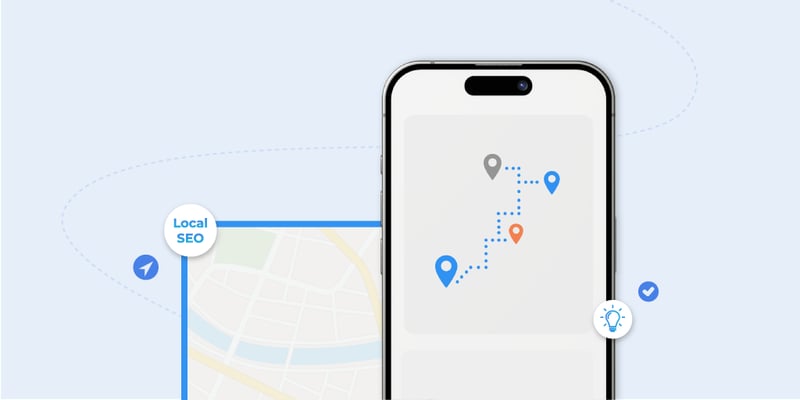46% of all Google searches are looking for local information, which means businesses need to have a strong strategy in place to ensure they're seen where it matters most. Let's dive into how you can build an effective Local SEO strategies for your multi-location brand.

What is a Local SEO Strategy?
Think of it as your roadmap to better local search visibility. It outlines the steps you'll take to outrank other local businesses using proven SEO tactics. Given that 72% of consumers who perform a local search visit a store within five miles, this roadmap is essential for driving foot traffic.
A good strategy covers:
- Your current position: What keywords are you ranking for now?
- Competitor analysis: Who's doing better than you and why?
- Areas for growth: Where can you improve your SEO efforts?
- Action plan: Tactics to boost your local search presence and attract customers.
Step 1: Assess Your Current Situation
Before jumping into tactics, conduct an audit to understand your current Local SEO performance. Identify your current keyword rankings, review your local listings, especially Google Business Profile for optimization gaps, and check for any inaccuracies. Rather than just focusing on NAP consistency everywhere, prioritize structured data and ensure major directories have correct information.
Step 2: Competitor Research
-
Identify Your Top Local Competitors
Look for businesses ranking higher in local search results as they might offer a blueprint for success in your market and niche.
- Search Locally: Identify who shows up in Google’s Local Pack, Apple Maps, and Bing Places.
- Use Tools: Tools like SEMrush or Ahrefs can show competitor rankings and backlinks.
-
Analyze Competitors' Google Business Profiles (GBP)
Your competitors’ Google Business Profiles reveal their strategy. Focus on:
- Categories: Ensure you're listed under the most relevant categories.
- Review Engagement: Match or exceed their review response rate.
- Posts: Regular updates via Google Posts improve visibility.
-
Study Their Online Reviews
Competitor reviews offer a glimpse into their customer interactions and Local SEO strategies.
- Volume: Track how many reviews they receive and aim to match their frequency.
- Sentiment: Learn from common praises or complaints to improve your own offering.
4. Examine Their Website Optimization
Competitor websites reveal SEO strengths and weaknesses.
- On-Page SEO: Analyze keyword usage in headings and titles.
- Schema Markup: Implement local business schema to enhance your visibility.
- Page Speed: Use Google PageSpeed Insights to match or exceed their load times.
Step 3: Identify Improvement Opportunities
Use data from your competitor research and site audit to highlight areas for growth.
Content Optimization: If your content is outdated or lacking, plan to create fresh, locally relevant content that speaks directly to your audience.
Review Management: Improve your engagement by responding to reviews more frequently and encouraging happy customers to leave feedback.
Listings & Citations: Ensure your business details are consistent across Google Business Profile (GBP) and all other platforms, but focus on quality citations over quantity to boost credibility and search rankings.
Local Link Building: Reach out to local businesses or directories for backlinks that improve your Local SEO.
Local marketing made easy. Sign-up to our Monthly Newsletter below.
Step 4: Optimize Local Listings and Citations
Ensuring that your business information is accurate and consistent across all platforms is a key driver for strong online visibility. 62% of consumers are likely to avoid a brand if they find incorrect or outdated information online. While maintaining consistency is important, citation citation volume is less critical today as quality matters more. Optimizing your Google Business Profile and maintaining accurate citations is still vital.
Additionally, ensure your website’s mobile speed is optimized, as most local searches happen on mobile devices. Make sure to implement structured data (Schema Markup) to improve visibility for search engines, making it easier for bots to crawl and rank your site.
Google Business Profile Optimization Tips:
- Keep Your Business Information Accurate
- Use High-Quality Visuals
- Select Relevant Attributes
- Highlight Products and Services
- Monitor and Respond to ALL Customer Reviews and Ratings
- Publish Regular Google Posts and Updates
Read through our Complete Google Business Profile Guide to learn more about each tactic.
Step 5: Leverage User-Generated Content and Reviews
Encouraging customer reviews and engaging with user-generated content (UGC) can significantly enhance your local search visibility. As 88% of consumers trust online reviews, building and managing your online reputation is essential for high visibility. Implement a review management strategy that encourages reviews on multiple platforms and responds to feedback quickly.
What if I Manage Multiple Locations?
For multi-location brands, building and managing a Local SEO strategy becomes even more complex, but it's critical for ensuring visibility across all locations. Beyond just maintaining accurate information, it involves optimizing each location for local search, managing reviews, and ensuring consistent engagement with your audience.
Local business listings management tools like PinMeTo can help streamline these efforts by centralizing your listings, enabling easy updates, and improving visibility across platforms like Google, Bing, and Apple Maps. PinMeTo’s solutions also support effective review management and localized content strategies, allowing each location to rank higher and engage more with local customers, ultimately driving more foot traffic and conversions.
To Sum Up
With 88% of consumers trusting online reviews and 72% acting on local searches, a strong local SEO strategy is crucial for multi-location brands to boost visibility, attract more customers, and drive growth. Optimizing for local search goes beyond maintaining NAP consistency, as it involves creating tailored, localized content, engaging with customer reviews, and ensuring every location is optimized for maximum impact. By effectively managing your online presence, you ensure each location is easily discoverable, ranks higher in search results, and delivers a seamless customer experience, both online and offline.
Looking for ways to level up your local visibility?
Give us an overview of your business below and we'll prepare a free local visibility audit
Lily Adamyan, October 3


